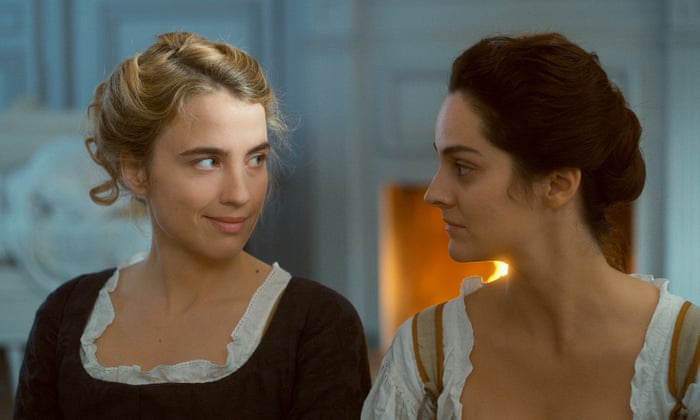Portrait of a Lady on Fire is one of those movies that had me laid out, bedridden, consumed and haunted for about six months after I first saw it. Much as I could spend a thousand words just rhapsodizing about how brilliant it is, how tender, how romantic, how erotic, how heart-breaking and moving and delicate and gorgeous, you’ve likely heard most of it already – if you haven’t had a chance to watch it yet, consider this your sign to put aside an afternoon, book in a week off work to process, and finally experience it. So, I’d like to narrow it down a bit to discuss some specific aspects of this amazing piece of lesbian cinema, and how writer-director Céline Sciamma uses the myth of Eurydice to explore the politics of love, looking, and longing in lesbian relationships!
Portrait of a Lady on Fire is a historical lesbian romance that unfolds on a remote island in Brittanty, as artist Marianne (Noémie Merlant) is commissioned to create a portrait of Héloïse (Adèle Haenel – whose critique of the film industry in the years since Portrait is a must-read), a young woman due to be married off to a male suitor after the suicide of her sister. There are so many themes and story elements wound throughout this movie – from abortion to desire, ownership and the connective tissue that art creates – but the one that stood out to me the most was that of looking.
About halfway through the movie, Héloïse and Marianne recount the story of Eurydice and Orpheus – a Greek myth wherein Orpheus travels to the underworld to rescue his love, Eurydice, and is gifted a chance to save her as long as he can lead her back into the world of the living without looking at her. Of course, he fails at the final hurdle, turning to greet her after he steps out of the underworld but before she has made the transition, dooming their romance once and for all. For Marianne, Orpheus makes the poet’s choice, one that captures Eurydice in his gaze – while Héloïse argues that he should have made the lover’s choice, to keep her in memory only. Like Orpheus, for Héloïse and Marianne to look upon each other – to acknowledge their relationship and their feelings – is to lose each other, due to the overring homophobia and interlocking social pressures placed on the two of them.
And it’s this metaphor that is woven so beautifully into the film as a lesbian narrative. The act of looking – and not looking – is central to how their relationship unfolds. Marianne is hired to capture an image of Héloïse, an image she destroys rather than allow to be seen through the eyes of a male suitor – later, she draws a self-portrait for Héloïse, gifting her a hidden image of herself that only Héloïse understands the significance of. In one of the movie’s climactic moments, Héloïse appears to Marianne in the wedding dress she’ll wear to be wed to her husband, and asks her to turn around to see her in it – Marianne agrees, taking the poet’s choice, seeing Héloïse as she really is, no matter how painful.
But perhaps the best example of this in the movie comes in the final few minutes, where, years after their ill-fated affair, Marianne and Héloïse end up at the same recital of Vivaldi’s The Four Seasons. From Marianne’s point of view, we see Héloïse staring at the stage – it’s a long, unbroken take that leads in to the end of the film, the epilogue to this romance. As the audience and Marianne watch Héloïse, you find yourself willing her to look over at her ex-lover; you want her to look, to acknowledge the relationship, both to herself and Marianne. But she doesn’t. It’s an ending that’s frustrating in the best way possible, as Héloïse makes the lover’s choice and keeps Marianne as a memory – in not looking at her, she protects the relationship from the outside world and preserves it in safety. Not looking, in this instance, is the biggest act of love she can show, keeping their relationship somewhere that homophobia and hatred can’t reach it. It’s as heart-breaking as it is romantic, the perfect end to a movie which is, in my eyes, immaculate from start to finish.
There’s so much fascinating text and subtext in Portrait of a Lady on Fire, and I’d love to hear about your interpretations of the movie below (and other brilliant lesbian romance films you think deserve to be ranked alongside it) – drop into the comments and let’s get into it!
If you enjoyed this article and want to see more stuff like it, please consider supporting us on Ko-Fi. You can check out more of my work on my personal blog, The Cutprice Guignol!
By Lou MacGregor
(header image via The Guardian)
